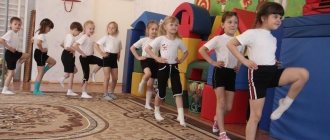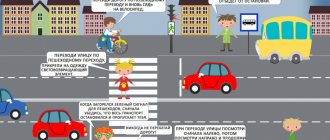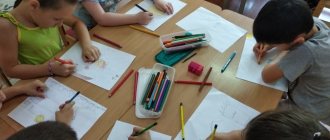MAGAZINE Preschooler.RF
1. Birthday Day We propose to introduce a tradition in the class - to celebrate birthdays every 1st day of the holidays: November 1 - autumn, January 1 - winter, March 24 - spring. June 1 - summer. An autumn ball can also be held on this day.2. Day of politeness and culture You can hold a tournament of knights of politeness, a fun express train in the labyrinth of etiquette, excursions to an art gallery, etc.
3. Health Day On this day, sports relay races, “Fun Starts”, “Call of the Jungle”, zoological races, fairy relay races, outdoor games, “Mom, Dad, I am a sports family”, a hike in the forest, an excursion to park "Autumn of our region".
4. Mother's Day You can hold competitions such as “Mom and Daughter”, “When Mom is Not at Home”, “My Mom’s Profession” (essay competition), the exhibition “My Mom Has Golden Hands”.
5. Labor Day Collective work - cleaning the classroom and the area, operation “Live the Book”. Collection of waste paper, exhibition of vegetables and fruits “Records of Nature”.
6. Day of games and toys This is a fairy tale day! Drawing competition “My Favorite Toy”, “Miss Barbie” competition, dramatization of fairy tales by A.S. Pushkin, KTD based on fairy tales, a cultural trip to the cinema or theater.
For children of secondary school age we offer the following forms of work:
Holidays - “Autumn Ball” - “At the Lukomorye” - “Holiday for everyone” - “Let there always be a mother” - Evening “I have grown up!”
Sports competitions, relay races, competitions: - “Fun Starts” - “Autumn Spartakiad” - “Healthy Family”
Talent competition “Who can do what?” Intellectual games: — “What? Where? When?" - "Erudite - show" - "Erudite - hockey"
For high school students: — Intellectual marathon; — Evening “Memories of Pushkin”; — “Star Hour” on the theme: “My native land”; — Day of “Joyful cooperatives”.
Let us dwell in detail on the organization and conduct of the day of “Joyful Cooperatives”, since the task of teachers is to involve as many high school students, unorganized, and difficult-aged children as possible in all types of educational work.
You can start the day with the celebratory opening of the avenue of cooperative institutions (cutting the red ribbon). Establish a symbolic comic fee for entry and service. In the “bank” you can exchange real money for badges, humor, coupons or other “currency”.
Fair booth - sellers in unusual costumes. On display cases and counters (tables) there are handmade crafts. At the fair you can buy confectionery products - pies, brushwood, etc. On the avenue there is a cinema or video salon, the Vstrecha cafe, a hairdresser, an information desk, and a literary registry office. At the end of the day there is a fun auction and disco.
When drawing up a plan for the holidays, it is recommended to: - provide for extracurricular work with students of primary, middle and high school age; — provide for work with children with deviant behavior; — provide for work with parents; — provide individual work with disabled children and orphans; — consider interaction with parole and with cultural and sports institutions (swimming pools, libraries, cultural centers); - create a work schedule for the school library; — draw up a work schedule for the gym, video room; — to provide for the organization of sports and mass recreational work; — provide educational activities for older students; — to provide for the organization of excursions, cultural trips, hiking trips, with a mandatory exit order; — provide for work with children's public organizations, self-government bodies, and training for school activists.
We wish you a useful and pleasant holiday!
| Next > |
Planning for the preparatory group “Autumn Holidays”
Valentina Shchadnova
Planning for the preparatory group “Autumn Holidays”
Autumn holidays ( preparatory group )
Goals: - Using a variety of activities, create an emotionally positive mood in children.
— Preserve and strengthen the neuropsychic health of children.
— develop children’s creative abilities through theatrical activities.
1 day 5. 11. 14 " Autumn lessons in politeness "
Morning: Conversation “Who came up with the rules of behavior and why?”
-involve children in verbal dialogue.
Reading and discussion (from the book “The newest rules of conduct for well-mannered children”
G. L. Shalaeva):
“How to behave
in the fall ?” -form the basic rules of etiquette.
P/n with a ball “Who knows more polite words?”
— practice children in pronouncing polite words, dexterity when receiving the ball from the teacher.
Walk: Competition “Who is faster?”
- activate children's memory;
develop the ability to differentiate the actions of heroes and evaluate them.
Tasks: “How is it possible?”
(politely ask, politely address, politely refuse, thank, say goodbye) - give an idea of the etiquette of communicating with peers and adults.
p/i "Away"
— practice children’s polite behavior in specific situations.
Sl. and "Good - bad"
- the ability to evaluate the actions of other children.
Evening: S.R.I. “In the store”
-expand the content of game plots.
Phone games: “How do I talk on the phone?”
— expand the social experience of children; develop dialogic communication.
Reading Works from the book by G. A. Shalaeva “Lessons in Politeness”
-develop interest in fiction, the ability to express judgments about the behavior of characters in works, and consolidate knowledge about the rules of good manners.
Day 2: 6.11.14 “Day of Theater and Cartoons”
Morning: R/i “Find out which cartoon the hero is from?”
-develop imagination, speech, interest in cartoon characters.
Psycho-gymnastics: “Leopold the Cat and the Mice”
-develop pontomic expressiveness, emotional, communication
new sphere of children.
d/i “Complete the hero”
-develop imagination, memory. visual skills.
p/i "Wolf and Hares"
- develop dexterity, the ability to move in accordance with the text.
Walk: Excursion to the park of cartoon characters “Athletes from the country of Multi-remote”
-develop acquired physical skills, agility, general endurance; bring joy from movement and communication.
Evening: Listening to songs from cartoons - develop interest in musical creativity, encourage singing familiar songs, focus on the moral basis of songs from cartoons.
Watching your favorite cartoons helps develop attention, imagination, and the ability to empathize with cartoon characters.
Day 3 11/7/14 “Journey to the land of road signs”
Morning: Conversation: “When did traffic rules appear?”
—
activate traffic rules in children’s speech, stimulate the process of reproducing memory images and knowledge about the world around them.
Sl/i "Rules of a little pedestrian"
- develop thinking, listening skills, attention, speech, increase vocabulary.
Review of the album “On the Road”
- develop logical thinking, the ability to evaluate the actions of other people.
p/i “Running traffic light?”
- consolidate knowledge about traffic lights.
Walk: “Through the streets of our village”
- develop an understanding of the need for rules and their implementation.
r/i "Best pedestrian"
-form ideas about traffic rules
p/i "Skillful pedestrian"
-to form in children a system of research activities adequate to the subject and setting
(possible or not; dangerous-safe, etc.)
Evening: Entertainment “In the World of Signs”
— teach children to distinguish road signs. Strengthen children's knowledge of traffic rules. Develop the ability to independently use the acquired knowledge in everyday life.
d/i “What and where?”
- teach the rules of crossing streets.
d/i “Where from?”
- to establish the rules of behavior for pedestrians at bus stops and crossing intersections after getting off the bus.
Oh! Page not found.
Hazard color scale
The Ministry of Emergency Situations informs: To identify the degree of hydrometeorological danger and for a better perception of weather forecasts containing warnings about adverse and dangerous meteorological phenomena, special color codes have been introduced on the territory of the Republic, including green, yellow, orange and red.
Hazard color scale
| Gradations | Forecasted risks |
| Green | The weather is not dangerous, no dangerous or adverse weather conditions are expected. |
| Yellow | the weather is potentially dangerous; adverse weather phenomena expected in some places (precipitation, thunderstorms, gusts of wind, high or low temperatures, etc.) are common in the region, but may pose a danger to certain types of socio-economic activities. |
| Orange | in most of the territory, adverse events are expected, in some places - dangerous events (squalls, downpours, thunderstorms, hail, heat, frost, snowfalls, blizzards, etc.), which can negatively affect socio-economic activities and lead to significant material damage, and human casualties are also possible. |
| Red | the weather is very dangerous, meteorological phenomena of extreme intensity are expected (very heavy rain and snowfall, large hail, very strong winds, extreme fire danger, etc.), which can cause serious property damage and loss of life. |
You can quickly find out the hydrometeorological situation in the Republic of Belarus using the application of the Ministry of Emergency Situations of Belarus “Help Nearby”, which also contains a list of recommendations to the population when transmitting messages about predicted weather conditions,
as well as in the media and on the map of adverse events: https://mchs.gov.by/operativnaya-informatsiya/karta-neblagopriyatnykh-yavleniy/
SAMPLE LIST
recommendations on rules of conduct for the population when forecasting adverse weather events
- STRONG WIND (INCLUDING SQUARL)
Recommendations for the public in strong winds:
Remove household items from the yard and balconies into the house (basement), trim dry trees that can cause damage to your home.
Place the car in the garage; if there is no garage, the car should be parked away from trees and weakly reinforced structures.
When outside, avoid shaky buildings and houses with unstable roofs.
Avoid trees and various high-risk structures (bridges, overpasses, pipelines, power lines, potentially hazardous industrial facilities).
- HEAVY RAIN, HEAVY RAIN
Recommendations for the population in case of heavy rain, heavy downpour, heavy rain and snow:
If you receive information about heavy rain or downpour, if possible, refrain from traveling around the city and stay in your apartment or at work.
When you are outside, use protective equipment: umbrella, waterproof raincoat, rubber boots.
If heavy rain catches you outside, do not go down into open underground passages or other buried rooms. Try to take shelter in buildings located above the possible flood level.
If the building (room) you are in is flooded, try to leave it and move to the nearest hill.
If rain catches you in your personal vehicle, do not try to overcome flooded areas, but try to go around them.
- HAIL
Recommendations for the population during hail:
If possible, do not leave the house during a hailstorm; while outside, try to choose shelter.
Use umbrellas or available means (bag, clothes) to protect your head from hail.
Remember that the average duration of a hail storm is approximately 6 minutes, and it is very rare that it lasts longer than 15 minutes.
- FOG
Recommendations for the public during fog:
Fog poses a danger to all road users. When driving in fog in a car, you should avoid unnecessary lane changes, overtaking, and advances.
Most traffic accidents in foggy conditions involve the vehicle in front. It is important to take into account that fog conceals the distance - it is advisable to increase the usual distance and reduce the speed.
Sudden braking should be avoided: if it is necessary to stop, the speed should be reduced smoothly. You should press the brake pedal several times, thereby giving a signal to warn drivers of cars moving behind you. When driving in fog, driver fatigue increases; caution is not unnecessary.
If you learn from the weather forecast that fog is expected, avoid traveling if possible, and avoid going to the forest or fishing from a boat. If you, being in nature, notice thickening of the fog, you should take measures in order not to lose orientation in the forest or on a body of water.
For reference:
Adverse meteorological phenomenon - fog - fog with visibility values of 500 m or less, lasting 3 hours or more.
- HEATWAVE
Recommendations for the public during extreme heat:
Try to stay in direct sunlight as little as possible. If this is unavoidable, protect your head with hats and umbrellas.
Remember that from 12.00 to 16.00 the sun is most active. At this time, it is advisable to protect all parts of the body from sunlight - use closed clothing and sunscreen.
Do not drink alcohol - in the heat its effect on the body increases many times over, plus the body becomes more sensitive to high temperatures.
Try to drink as much liquid as possible (chilled water, mineral water).
Do not buy food by hand - at high temperatures, bacteria multiply very quickly, which can lead to severe poisoning if food is stored improperly.
Do not use decorative cosmetics at all or reduce its use to a minimum: in the heat, our skin breathes and sweats intensely, thereby reducing our body temperature. Clogged pores can cause the body to overheat.
Do not engage in active sports at temperatures above 25°C.
Try to maintain emotional calm, because... Any overexcitation increases the risk of heatstroke or sunstroke.
If possible, you should limit long trips by car; if this is not possible, be as careful as possible on the road, because During the heat, your health may worsen, your attention may be distracted and your reaction will decrease.
Do not leave children in a stationary car, even for a short time. In hot conditions, this can cause the child to faint.
For reference:
Unfavorable meteorological phenomenon – extreme heat – maximum air temperature +30 +34°C
- STORM
Recommendations for the public during thunderstorms:
To avoid being struck by lightning, follow these guidelines.
If you are at home, then:
If you are in a rural area: close windows, doors, chimneys and vents. Do not light the stove because the high temperature gases coming out of the stove pipe have low resistance. Do not talk on a wired telephone: lightning sometimes strikes wires stretched between poles.
During lightning strikes, do not come close to electrical wiring, lightning rods, roof gutters, antennas, do not stand near a window, and if possible, turn off the TV, radio and other electrical appliances.
If you are in an open area:
Remember that lightning strikes the highest point on its path. A large tree, a lonely man in a field, is this high point.
That's why:
do not hide under tall trees (especially lonely ones);
in the absence of shelter, you should lie down on the ground or sit down in a dry hole or trench, bending your head;
when staying in the forest during a thunderstorm, you should take cover among low-growing vegetation;
if a group of people is sheltering, then it is better to squat down without coming into contact with other people;
during a thunderstorm you cannot swim in bodies of water;
You should not run during a thunderstorm;
if you are riding a bicycle or motorcycle, stop driving, leave them and wait out the thunderstorm at a distance of about 30 meters from them;
During a thunderstorm, you should stay away from power lines, because electricity attracts lightning;
if you are on a hill, go down;
If you are in a boat during a thunderstorm, row to shore;
If you are driving a car during a thunderstorm, stop and close the windows, stay in the car.
If struck by lightning:
first of all, the victim must be undressed, douse his head with cold water and, if possible, wrap his body in a wet, cold blanket;
if the person has not yet regained consciousness, it is necessary to perform mouth-to-mouth artificial respiration and call for medical help as quickly as possible.
SAMPLE LIST
recommendations on rules of behavior for the population when forecasting hazardous natural phenomena
- VERY STRONG WIND (INCLUDING SQUARL AND TOrnado)
Recommendations for the public in very strong winds
If you receive information about very strong winds, refrain from traveling around the city; if possible, stay in your apartment or at work. Turn on wired and radio broadcasting equipment.
Stay calm, warn your neighbors, provide assistance to the disabled, children, and the elderly.
Since there may be a power outage, prepare for a power outage and close the gas taps.
Remove household items from the yard and balconies into the house (basement), trim dry trees that can cause damage to your home.
Place the car in the garage; if there is no garage, the car should be parked away from trees and weakly reinforced structures.
Close doors, windows, attic hatches and vents tightly. If possible, protect window glass with shutters or shields.
Teach children what to do during a natural disaster.
If you are on the street, avoid shaky buildings and houses with unstable roofs;
Avoid trees and various high-risk structures (bridges, overpasses, pipelines, power lines, potentially hazardous industrial facilities).
Beware of parts of structures and objects hanging on buildings, downed power line wires, broken glass and other sources of danger
If you are on a boat and receive a storm warning or see bad weather approaching, move to shore immediately.
Avoid shaky buildings and houses with unstable roofs if disaster finds you on the street.
Avoid various high-risk structures (bridges, overpasses, pipelines, power lines, bodies of water, transport stops, potentially hazardous industrial sites and trees).
If the wind speed increases and reaches hurricane force, then you must follow the rules:
when in an open area, press yourself tightly to the ground at the bottom of any depression (ravine, ditch), protecting your head with clothing;
stop if you are driving a car, do not hide in it, try to find shelter in a strong structure or at the bottom of any depression.
- VERY HEAVY RAIN (VERY HEAVY RAIN)
Recommendations for the public during very heavy rain (very heavy rain):
If you receive information about heavy precipitation, refrain from traveling around the city; if possible, stay in your apartment or at work. Turn on wired and radio broadcasting equipment.
If a downpour catches you outside, do not go down into underground passages or other buried rooms. Try to take shelter in buildings located above the possible flood level.
If the building (room) you are in is flooded, try to leave it and move to the nearest hill.
If it is not possible to leave the building, then go up to the higher floors, turn off the electricity and gas, close the windows and doors tightly and report your location to the emergency service on duty by calling 101 or 112.
If a downpour catches you in your personal vehicle, do not try to cross flooded areas. Slowly change lanes to the far right (to the side of the road) and, without resorting to emergency braking, stop driving. Turn on your hazard lights and wait out the downpour. In cases of rapid water flow, leave the vehicle and go to an elevated area or to a nearby building.
- LARGE CITY
Recommendations for the population during large hail:
If possible, do not leave the house, while indoors, stay as far away from windows as possible. Do not use electrical appliances, because Hail is usually accompanied by thunderstorm activity.
When outdoors, try to find shelter. If this is not possible, protect your head from hail strikes (cover your head with your hands, bag, clothes).
Do not try to find shelter under trees, because... There is a high risk of not only being struck by lightning, but also that large hailstones and strong winds can break tree branches, which can cause additional damage to you.
If you are driving a car, stop driving. When in a car, stay away from the windows. It is advisable to turn your back to them (facing the center of the cabin) and cover your eyes with your hands or clothes. If you have small children with you, then you need to cover them with your body, and also cover your eyes either with clothes or with your hand. If the dimensions of the cabin allow, it is best to lie on the floor.
Never leave your car during a hail storm. Remember that the average duration of a hail storm is approximately 6 minutes, and it is very rare that it lasts longer than 15 minutes.
- HEAVY FOG
Recommendations for the public during heavy fog:
Fog poses a danger to all road users. When driving in fog in a car, you should avoid unnecessary lane changes, overtaking, and advances.
Most traffic accidents in foggy conditions involve the vehicle in front. It is important to take into account that fog obscures the distance - it is advisable to increase the usual distance. In all cases, the speed in fog should be lower than the speed in clear weather. When choosing a speed, it is necessary to proceed from the possibility of stopping the car within sight.
Sudden braking should be avoided: if it is necessary to stop, the speed should be reduced smoothly. You need to press the brake pedal several times, thereby giving a signal to warn drivers of cars moving behind you. Driving in fog increases driver fatigue.
When visibility in fog deteriorates to 50 m or less, traffic stops.
If you learn from the weather forecast that heavy fog is expected, avoid going into the forest or fishing from a boat. If you, being in nature, notice thickening of the fog, you should take measures in order not to lose orientation in the forest or on a body of water.
During the cold season, heavy fog contributes to the occurrence of another dangerous phenomenon - icy conditions.
For reference:
Dangerous meteorological phenomenon - heavy fog - fog with a visibility value of 50 m or less, lasting at least 12 hours.
- VERY HEAT
Recommendations for the general public during extreme heat:
Try to stay in direct sunlight as little as possible. If this is unavoidable, protect your head with hats and umbrellas.
From 12.00 to 16.00 the sun is most active, at this time it is advisable to protect all parts of the body from sunlight - use closed clothing and sunscreen.
Do not drink alcohol - in the heat its effect on the body increases many times over, plus the body becomes more sensitive to high temperatures.
Try to drink as much liquid as possible (chilled water, mineral water).
Do not buy food by hand - at high temperatures, bacteria multiply very quickly, which can lead to severe poisoning if food is stored improperly.
Do not use decorative cosmetics at all or reduce its use to a minimum: in the heat, our skin breathes and sweats intensely, thereby reducing our body temperature. Clogged pores can cause the body to overheat.
Do not engage in active sports at temperatures above 25°C.
Try to maintain emotional calm, because... Any overexcitation increases the risk of heatstroke or sunstroke.
If possible, you should limit long trips by car; if this is not possible, be as careful as possible on the road, because During the heat, your health may worsen, your attention may be distracted and your reaction will decrease.
For reference:
Dangerous meteorological phenomenon – very intense heat – maximum air temperature +35°C and above.
- DROUGHT
Recommendations for the population during drought:
Create water reserves:
in houses (using bathtubs, any large-capacity enamel containers), in garden plots (by filling all available containers with water, placing them in the shade, or better yet, burying them in the ground).
Use water sparingly.
Determine the presence of lakes, swamps, and streams near houses and gardens as additional sources of water.
Keep domestic animals indoors (barn, barn), and provide them with a 2-3-day supply of water.
Do not light open fires near residential buildings, outbuildings and garden areas.
Carefully listen to information from local executive authorities about the situation and carry out the actions recommended in these conditions.
- EXTREME FIRE HAZARD
Recommendations for the public in case of extreme fire danger:
All citizens living in rural areas or on vacation in nature need to be especially attentive and vigilant at this time.
Remember that it is easier to prevent a fire than to extinguish it.
Do not endanger your life and the lives of your loved ones.
Protect your home and property from fire.
Follow fire safety rules:
do not light fires in forests;
be careful when handling matches and other flammable objects, do not throw unextinguished cigarettes;
Do not burn garbage unnecessarily in your garden and dacha plots and near forests and forest plantations. Remember that this is especially dangerous in strong winds;
We draw the attention of parents: keep an eye on your children so that a child's prank does not turn into a big fire.
For reference:
Dangerous meteorological phenomenon - extreme fire danger - values of fire danger indicators corresponding to class 5 (10000oC or more on the Dichenkov scale).





